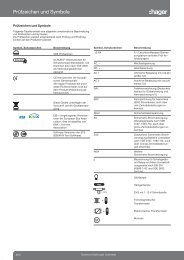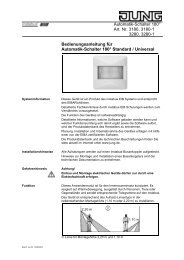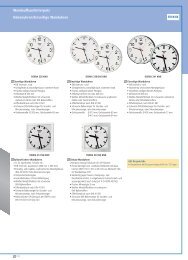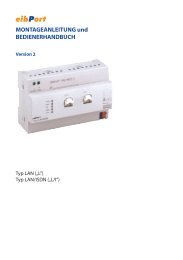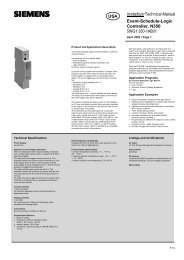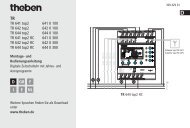You also want an ePaper? Increase the reach of your titles
YUMPU automatically turns print PDFs into web optimized ePapers that Google loves.
Subsequent alarm<br />
If an additional detector of an armed security area triggers after a prior alarm, then a subsequent<br />
alarm is activated. In so doing, the internal configured siren is again triggered and, if<br />
necessary, switched on again. A detector which previously triggered an alarm cannot trigger a<br />
second subsequent alarm.<br />
A subsequent alarm is always activated without delay, even with a planned alarm delay.<br />
An subsequent alarm and the detector causing it are logged in the event memory of the panel<br />
(see chapter 4.2.4.12.6. Event memory). In addition, the signalling system uses the<br />
14 byte object "Alarm detector text" to display the detector text configured in the ETS plug-in of<br />
the detector which triggered the alarm.<br />
Alarm acknowledgement / "Unarmed after alarm"<br />
Each alarm must be acknowledged directly on the panel. Without alarm acknowledgement, it is<br />
not possible to switch to "Unarmed" status and thus additional arming. The system operator can<br />
acknowledge an alarm in the status "Unarmed after alarm".<br />
Primarily, there are two methods of acknowledging an alarm...<br />
- Separate unarming + acknowledgement:<br />
An active alarm (internal siren + "Alarm" object switched on) can - as described above - be<br />
deactivated by unarming. The system switches the internal siren off if it has not already<br />
been switched off automatically, transmits a "0" telegram to the bus via the "Alarm" object<br />
and an unarmed acknowledgement to the bus and switches to the status "Unarmed after<br />
alarm". The visual alarm (for external alarming) remains switched on.<br />
In the "Unarmed after alarm" status, the operator can the inspect the event memory directly<br />
on the panel to see which detector triggered the alarm at which time. Usually, the alarm<br />
can then be confirmed by pressing the "Acknowledge" button on the panel and then reset<br />
completely. The system then switches the visual signal off (for external alarms) and then<br />
switches to the "Unarmed" status. In this case, there is no additional unarming acknowledgement.<br />
The panel transmits the text "No alarm" to the bus via the 14 byte object "Alarm<br />
detector text".<br />
In the "Unarmed after alarm" status, the piezo buzzer of the panel is controlled in order to<br />
alert the user to go to the panel and acknowledge the alarm.<br />
- Unarming by acknowledgement:<br />
An alarm can also be acknowledged directly without separate unarming and thus reset. For<br />
example, such behaviour is wise when the internal siren set for a specific time after an<br />
alarm has already turned quiet, i.e. need not be turned offer, or the system is operated directly<br />
on the panel. For this, the "Acknowledge" button can be pressed on the signalling side<br />
of the panel in the "Alarm" status.<br />
With such operation, the signalling system completely deactivates the alarm and acknowledges<br />
it at the same time. Deactivating the alarm switches off the visual alarm (for external<br />
alarms) and the internal siren, if this has not already been switched off automatically. In addition,<br />
the system transmits a "0" telegram via the "Alarm" object and the text "No alarm" to<br />
the bus via the 14 byte object "Alarm detector text". The system then immediately switches<br />
to the status "Unarmed" without any separate unarming acknowledgement. This type of operation<br />
does not set the status "Unarmed after alarm".<br />
Before or after the "Acknowledge" button is pressed, the system operator can the inspect<br />
the event memory directly on the panel to see which detector triggered the alarm at which<br />
time.<br />
i After an alarm has been acknowledged, the system automatically switches to the "Fault"<br />
status, if, for example, the sabotage input was the detector triggering the alarm. This subsequent<br />
fault must then be acknowledged separately on the panel. The cause of the fault<br />
must have been eliminated for a fault message to be acknowledged (see chapter<br />
4.2.4.12.5. Fault).<br />
Order-No. 7574 00 1X<br />
Software "...590101"<br />
Functional description<br />
Page 123 of 222






